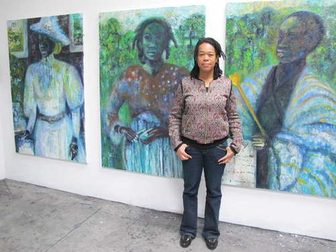The right painting of the triptych is a fictional portrait of granman Fabi Labi Dikan, the most important man of the Dikan. He was the first to conclude a treaty between his tribe and the Dutch government on Oct. 10, 1760. The Dikan belong to the Ndyuka (formerly also called Aukaners or Okanisi), one of the maroon communities in Suriname. From the beginning of slavery, enslaved people fled from the plantations. Often they were men who had been captured and sold in Africa and had endured the arduous crossing. In the eighteenth century, some 200 to 300 slaves ran away annually, usually in small groups of two or three. Running away was not so difficult, but survival in the jungle was. Some returned to the plantations. The others formed communities in the interior. They survived by hunting and growing vegetables, such as cassava. They traded and exchanged knowledge with indigenous tribes. In different parts of Suriname, different Maroon groups formed with their own language.
Cattle on the loose
In the 18th century, refugees were called runaways by settlers. Even they called themselves businengee (forest nigger), but that is now considered derogatory. Boslandcreole is also used, but mostly maroon, which, as in the rest of the Caribbean, is the designation of fugitive slaves. Nor is the word very positive, as it is derived from the Spanish word cimarrón, the designation for "cattle on the loose.
From the slaves who had stayed behind on the plantation, the Maroons sometimes received tools and extra food. But they also undertook raids, also voluntarily or involuntarily taking women with them. There were far fewer women in the maroon communities because many more men ran away. Planters and the government sent armed patrols to the maroon villages to capture people and destroy their boarding grounds and huts. By 1750, there were now around 3,000 people living in the "runaway villages" as they are shown on a map of Suriname. Governor Jan Mauritius recognized that, following Jamaica's example, he might do better to make a treaty with the Maroons. One of the Ndyuka captains, Boston Band, was from Jamaica. He had fled, after selling to an owner in Suriname, to the interior. Boston was one of the few who could read and write. After raiding plantations, he left letters calling for a peaceful solution.
Peace
After long negotiations, a peace treaty was signed between Fabi Labi Dikan and the representatives of the Dutch governor Wigbold Crommelin on October 10, 1760. The "satisfied Negroes" were recognized as free people. They had to respect official authority, but were allowed to have their own legal system. However, they had to settle at least 10 hours by boat from the plantations. In exchange for goods, they had to hand over new runaways to the Dutch government. The website Slavery and You has more on the consequences of the treaties. Later, treaties were made with other groups such as the Saamaka. Other Maroon groups, such as the Boni, remained at war with the colonial government. The date of Oct. 10 is commemorated annually in Suriname during Maroon Day, in remembrance of the 1760 treaty.

Waardigheidstekens
Ook van Fabi Labi Dikan is, net zo min als van Elisabeth Samson en Wilhelmina (van) Kelderman, een portret bekend. In de zesde bepaling van het verdrag werd iets gezegd over de waardigheidstekens van granman Fabi Labi Dikan. De Aukaners, zoals ze in het verdrag genoemd worden, moesten bij het overlijden van hun granman de overheid informeren over diens opvolger. Na de toestemming zou die de waardigheidstekens krijgen. Zo heeft Iris Kensmil de granman geschilderd, met het verdrag en een staf als teken van waardigheid in zijn handen.